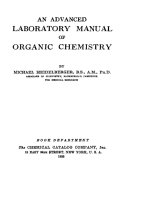rauk - orbital interaction theory of organic chemistry 2e (wiley, 2001)
Bạn đang xem bản rút gọn của tài liệu. Xem và tải ngay bản đầy đủ của tài liệu tại đây (7.21 MB, 366 trang )
ORBITAL INTERACTION
THEORY OF ORGANIC
CHEMISTRY
Second Edition
Orbital Interaction Theory of Organic Chemistry, Second Edition. Arvi Rauk
Copyright ( 2001 John Wiley & Sons, Inc.
ISBNs: 0-471-35833-9 (Hardback); 0-471-22041-8 (Electronic)
Orbital Interaction Theory of Organic Chemistry, Second Edition. Arvi Rauk
Copyright ( 2001 John Wiley & Sons, Inc.
ISBNs: 0-471-35833-9 (Hardback); 0-471-22041-8 (Electronic)
ORBITAL INTERACTION
THEORY OF ORGANIC
CHEMISTRY
Second Edition
ARVI RAUK
Professor Emeritus
University of Calgary, Canada
A John Wiley & Sons, Inc., Publication
New York
Chichester
Weinheim
Brisbane
Singapore
Toronto
Designations used by companies to distinguish their products are often claimed as trademarks.
In all instances where John Wiley & Sons, Inc., is aware of a claim, the product names appear
in initial capital or all capital letters. Readers, however, should contact the appropriate
companies for more complete information regarding trademarks and registration.
Copyright ( 2001 by John Wiley & Sons, Inc. All rights reserved.
No part of this publication may be reproduced, stored in a retrieval system or transmitted in any
form or by any means, electronic or mechanical, including uploading, downloading, printing,
decompiling, recording or otherwise, except as permitted under Sections 107 or 108 of the 1976
United States Copyright Act, without the prior written permission of the Publisher. Requests to
the Publisher for permission should be addressed to the Permissions Department, John Wiley &
Sons, Inc., 605 Third Avenue, New York, NY 10158-0012, (212) 850-6011, fax (212) 850-6008,
E-Mail: PERMREQ @ WILEY.COM.
This publication is designed to provide accurate and authoritative information in regard to the
subject matter covered. It is sold with the understanding that the publisher is not engaged in
rendering professional services. If professional advice or other expert assistance is required, the
services of a competent professional person should be sought.
ISBN 0-471-22041-8
This title is also available in print as ISBN 0-471-35833-9.
For more information about Wiley products, visit our web site at www.Wiley.com.
CONTENTS
PREFACE xiii
1 SYMMETRY AND STEREOCHEMISTRY 1
Purpose / 1
De®nition of a Group / 2
Molecular Point Groups / 2
Schoen¯ies Notation / 2
Interrelations of Symmetry Elements / 3
Type Classi®cation / 3
Isomerism and Measurements / 6
Stereoisomerism of Molecules / 8
Stereotopic Relationships of Groups in Molecules / 9
Asymmetric Synthesis and Stereochemistry / 10
NMR and Stereochemistry / 12
Symmetry and Structural Parameters / 14
Note on Hybridization / 15
Symmetry and Orbitals / 16
Atomic Orbitals / 16
Molecular and Group Orbitals / 17
In What Combination? / 19
2 MOLECULAR ORBITAL THEORY 20
Introduction / 20
Electronic Schro
È
dinger Equation (A.1) / 21
v
Fock Equations (A.42) / 23
The Basis Set (STO-3G, 6-31G*, and All That) / 24
Orbital Energies and Orbitals / 25
Representation of MOs / 27
Total Energies and the Hartree±Fock Limit / 29
Successes and Failures of Hartree±Fock Theory / 29
Beyond Hartree±Fock / 30
Density Functional Theory / 31
Geometry Optimization / 31
Normal Coordinates and Harmonic Frequency Analysis / 32
Zero Point Vibrational Energies / 33
3 ORBITAL INTERACTION THEORY 34
Relationship to Hartree±Fock Equations / 34
Hu
È
ckel Approximation / 34
Orbital Energies and Total Electronic Energy / 34
Case Study of a Two-Orbital Interaction / 35
Case 1: e
A
e
B
,S
AB
0/38
Case 2: e
A
e
B
,S
AB
b 0, S
AB
f 1/39
Case 3: e
A
b e
B
,S
AB
0/40
Case 4: e
A
b e
B
,S
AB
b 0/42
E¨ect of Overlap / 44
Energetic E¨ect of Overlap / 44
Orbital E¨ect of Overlap / 44
First Look at Bonding / 45
Relationship to Perturbation Theory / 45
Generalizations for Intermolecular Interactions / 46
Energy and Charge Distribution Changes from Orbital Interaction / 47
Four-Electron, Two-Orbital Interaction / 47
Three-Electron, Two-Orbital Interaction / 48
Two-Electron, Two-Orbital Interaction / 49
One-Electron, Two-Orbital Interaction / 51
Zero-Electron, Two-Orbital Interaction / 51
Interactions between Molecules: Many Electrons, Many Orbitals / 52
General Principles Governing the Magnitude of h
AB
and S
AB
/52
Interactions of MOs / 52
Electrostatic E¨ects / 55
Group Orbitals / 56
Zero-Coordinated Atoms / 56
Monocoordinated Atoms / 57
Dicoordinated Atoms / 58
Tricoordinated Atoms / 59
Tetracoordinated Atoms / 59
vi CONTENTS
Assumptions for Application of Qualitative MO Theory / 61
Example: Carbonyl Group / 62
Construction of Interaction Diagram / 62
Interpretation of Interaction Diagram / 65
Chemical Reactivity / 66
Why Does It Work and When Might it Not? / 69
4 SIGMA BONDS AND ORBITAL INTERACTION THEORY 72
CÐX s Bonds: X C, N, O, F and X F, Cl, Br, I / 72
s Bonds: Homolytic versus Heterolytic Cleavage / 74
Heterolytic Cleavage of s Bonds Involving C or H / 74
Homolytic Cleavage of s Bonds Involving C or H / 75
Homonuclear s Bonds CÐC, NÐN, OÐO, FÐF, ClÐCl,
BrÐBr, and IÐI / 76
Interactions of s Bonds / 77
s Bonds as Electron Donors or Acceptors / 81
s Bonds as Electron Acceptors / 81
As a s Acceptor / 81
As a p Acceptor / 82
s Bonds as Electron Donors / 83
As a s Donor / 83
As a p Donor / 84
Bonding in Cyclopropane / 84
5 SIMPLE HU
È
CKEL MOLECULAR ORBITAL THEORY 86
Simple Hu
È
ckel Assumptions / 86
Charge and Bond Order in SHMO Theory: (S
AB
0, One Orbital per
Atom) / 91
Electron Population and Net Charge of Center A / 91
Bond Order between Centers A and B / 92
Factors Governing Energies of MOs: SHMO Theory / 92
Reference Energy and Energy Scale / 92
Heteroatoms in SHMO Theory / 93
E¨ect of Coordination Number on and /93
Hybridization at C in Terms of and /96
Gross Classi®cation of Molecules on the Basis of MO Energies / 96
6 REACTIONS AND PROPERTIES OF
p
BONDS 98
Reactions of Ole®ns (Alkenes) / 98
E¨ect of X
:
Substituents / 99
E¨ect of Z Substituents / 101
E¨ect of ``C'' Substituents / 101
E¨ect of Distortion of Molecular Skeleton / 102
CONTENTS vii
Alkynes / 103
p Bonds to and between Higher Row Elements / 103
p Bonds to Silicon, Phosphorus, and Sulfur / 103
7 REACTIVE INTERMEDIATES 105
Reactive Intermediates [CH
3
]
, [CH
3
]
À
, [CH
3
]
.
, and [
:
CH
2
] / 105
Carbocations / 105
Intermolecular Reactions of Carbocations / 106
Intramolecular Reactions of Carbocations / 107
Silyl Cations / 108
Carbanions / 108
Carbon Free Radicals / 110
Carbenes / 114
Nitrenes and Nitrenium Ions / 116
Nitrenes / 116
Nitrenium Ions / 118
8 CARBONYL COMPOUNDS 121
Reactions of Carbonyl Compounds / 121
Electrophilic Attack on a Carbonyl Group / 121
Basicity and Nucleophilicity of the Oxygen Atom / 122
Nucleophilic Attack on a Carbonyl Group / 124
Amide Group / 126
Thermodynamic Stability of Substituted Carbonyl Groups / 127
9 NUCLEOPHILIC SUBSTITUTION REACTIONS 129
Nucleophilic Substitution at Saturated Carbon / 129
Unimolecular Nucleophilic Substitution S
N
1 / 129
Bimolecular Nucleophilic Substitution S
N
2 / 130
Another Description of the S
N
2 Reaction: VBCM Model / 134
10 BONDS TO HYDROGEN 137
Hydrogen Bonds and Proton Abstraction Reactions / 137
Hydrogen Bonds / 137
Symmetrical and Bifurcated Hydrogen Bonds / 139
Proton Abstraction Reactions / 141
E2 Elimination Reaction / 143
E1cB Mechanism Reaction / 144
E1 Elimination Reaction / 144
Reaction with Electrophiles: Hydride Abstraction and Hydride
Bridging / 145
Activation by p Donors (X
:
and ``C'' Substituents) / 145
viii CONTENTS
Hydride Abstraction / 145
Hydride Bridges / 147
Reaction with Free Radicals: Hydrogen Atom Abstraction and One- or
Three-Electron Bonding / 147
Hydrogen-Bridged Radicals / 147
Hydrogen Atom Transfer / 148
11 AROMATIC COMPOUNDS 150
Reactions of Aromatic Compounds / 150
Cyclic p Systems by Simple Hu
È
ckel MO Theory / 150
Aromaticity in s-Bonded Arrays? / 151
Reactions of Substituted Benzenes / 152
Electrophilic Substitutions / 152
E¨ect of Substituents on Substrate Reactivity / 153
Electrophilic Attack on X
:
-Substituted Benzenes / 153
Electrophilic Attack on Z-Substituted Benzenes / 154
Electrophilic Attack on ``C''-Substituted Benzenes / 155
Electrophilic Attack on N Aromatics: Pyrrole and Pyridine / 155
Nucleophilic Substitutions / 157
E¨ect of Substituents on Substrate Reactivity / 158
Nucleophilic Attack on Z-Substituted Benzenes / 158
Nucleophilic Attack on N Aromatics: Pyrrole and Pyridine / 158
Nucleophilic Substitution by Proton Abstraction / 159
12 PERICYCLIC REACTIONS 161
General Considerations / 161
Cycloadditions and Cycloreversions / 162
Stereochemical Considerations / 162
Electrocyclic Reactions / 165
Stereochemical Considerations / 165
Cheletropic Reactions / 165
Stereochemical Considerations / 165
Sigmatropic Rearrangements / 166
Stereochemical Considerations / 166
Component Analysis (Allowed or Forbidden?) / 167
Rule for Component Analysis / 168
Diels±Alder Reaction / 169
Cope Rearrangement / 170
1,3-Dipolar Cycloaddition Reactions / 171
13 ORGANOMETALLIC COMPOUNDS 175
Transition Metals / 175
CONTENTS ix
Ligands in Transition Metal Complexes / 176
Orbitals in Transition Metal Bonding / 176
Orbital Energies / 178
Valence Orbitals of Reactive Metal Complexes / 179
Six Valence Orbitals of Tricoordinated Metal / 182
Five Valence Orbitals of Tetracoordinated Metal / 182
Four Valence Orbitals of Pentacoordinated Structure / 185
Transition Metals and CÐH or HÐH Sigma Bonds / 186
More About C Ligands in Transition Metal Complexes / 186
Chelating Ligands / 187
Organic p-Bonded Molecules as Ligands / 187
Transition Metal Bonding to Alkenes: Zeise's Salt / 187
Agostic Interaction / 191
Ziegler±Natta Polymerization / 192
Oxidative Addition to HÐH and CÐH Bonds / 194
14 ORBITAL AND STATE CORRELATION DIAGRAMS 196
General Principles / 196
Woodward±Ho¨man Orbital Correlation Diagrams / 197
Cycloaddition Reactions / 197
Electrocyclic Reactions / 198
Cheletropic Reactions / 201
Photochemistry from Orbital Correlation Diagrams / 201
Limitations of Orbital Correlation Diagrams / 203
State Correlation Diagrams / 203
Electronic States from MOs / 205
Rules for Correlation of Electronic States / 206
Example: Carbene Addition to an Ole®n / 206
15 PHOTOCHEMISTRY 209
Photoexcitation / 209
Jablonski Diagram / 210
Fate of Excited Molecule in Solution / 211
Dauben±Salem±Turro Analysis / 212
Norrish Type II Reaction of Carbonyl Compounds / 213
Norrish Type I Cleavage Reaction of Carbonyl Compounds / 215
APPENDIX A: DERIVATION OF HARTREE±FOCK THEORY 218
Electronic Hamiltonian Operator / 218
Electronic Schro
È
dinger Equation / 220
Expectation Values / 221
Many-Electron Wave Function / 221
x CONTENTS
Electronic Hartree±Fock Energy / 222
Variation of E
HF
/ 226
LCAO Solution of Fock Equations / 229
Integrals / 231
The Basis Set (STO-3G, 6-31G*, and All That) / 232
Interpretation of Solutions of HF Equations / 233
Orbital Energies and Total Electronic Energy / 233
Restricted Hartree±Fock Theory / 234
Mulliken Population Analysis / 236
Dipole Moments / 236
Total Energies / 237
Con®guration Energies / 237
Post-Hartree±Fock Methods / 239
Con®guration Interaction Theory / 239
Excited States from CI Calculations / 241
Many-Body Perturbation Theory / 241
Rayleigh±Schro
È
dinger Perturbation Theory / 241
Mùller±Plesset Perturbation Theory / 244
Density Functional Theory / 245
APPENDIX B: EXERCISES 247
Chapter 1 / 247
Chapter 2 and Appendix A / 249
Chapter 3 / 252
Chapter 4 / 262
Chapter 5 / 264
Chapter 6 / 272
Chapter 7 / 273
Chapter 8 / 278
Chapter 9 / 281
Chapter 10 / 281
Chapter 11 / 284
Chapter 12 / 288
Chapter 13 / 292
Chapter 14 / 296
Chapter 15 / 298
Miscellaneous / 301
REFERENCES AND NOTES 313
INDEX 325
CONTENTS xi
PREFACE
The premise on which this text is based is that the vast majority of chemical phenomena
may be qualitatively understood by the judicious use of simple orbital interaction dia-
grams. The material borrows heavily from the pioneering work of Fukui [1, 2], Wood-
ward and Ho¨mann [3], Klopman [4], Salem [5], Ho¨mann [6], and many others whose
work will be acknowledged throughout including Fleming: Frontier Orbitals and Organic
Chemical Reactions [7], from which a number of illustrative examples are extracted. If
there is uniqueness to the present approach, it lies in the introduction of the and of
simple Hu
È
ckel molecular orbital theory as reference energy and energy scale on which to
draw the interaction diagrams, mixing s and s* orbitals and nonbonded orbitals with
the usual p orbitals of SHMO theory on the same energy scale. This approach is di½cult
to justify theoretically, but it provides a platform on which the reader can construct his
or her interaction diagrams and is very useful in practice. Numerous illustrations from
the recent literature are provided.
The book is intended for students of organic chemistry at the senior undergraduate
and postgraduate levels and for chemists in general seeking qualitative understanding of
the (often) quantitative data produced by modern computational chemists [8]. All reac-
tions of organic compounds are treated within the framework of generalized Lewis acid±
Lewis base theory, their reactivity being governed by the characteristics of the frontier
orbitals of the two reactants. All compounds have occupied molecular orbitals and so
can donate electrons, that is, act as bases in the Lewis sense. All compounds have empty
molecular orbitals and so can accept electrons, that is, act as acids in the Lewis sense.
The ``basicity'' of a compound depends on its ability to donate the electron pair. This
depends on the energy of the electrons, the distribution of the electrons (shape of the
molecular orbital), and also on the ability of the substrate to receive the electrons (on the
shape and energy of its empty orbital). The basicity of a compound toward di¨erent
substrates will be di¨erent, hence a distinction between Lowry±Bronsted basicity and
nucleophilicity. A parallel de®nition applies for the ``acidity'' of the compound. The
xiii
structures of compounds are determined by the energetics of the occupied orbitals. Fine
distinctions, such as conformational preferences, can be made on the basis of maximiza-
tion of attractive interactions and/or minimization of repulsive interactions between
the frontier localized group orbitals of a compound. All aspects are examined from the
point of view of orbital interaction diagrams from which gross features of reactivity and
structure ¯ow naturally. The approach is qualitatively di¨erent from and simpler than,
a number of alternative approaches, such as the VBCM (valence bond con®guration
mixing) model [9] and OCAMS (orbital correlation analysis using maximum symmetry)
approach [10, 11].
The organization of the text follows a logical pedagogical sequence. The ®rst chapter
is not primarily about ``orbitals'' at all but introduces (or recalls) to the reader elements
of symmetry and stereochemical relationships among molecules and among groups
within a molecule. Many of the reactions of organic chemistry follow stereochemically
well-de®ned paths, dictated, it will be argued, by the interactions of the frontier orbitals.
The conceptual leap to orbitals as objects anchored to the molecular framework which
have well-de®ned spatial relationships to each other is easier to make as a consequence.
Whether or not orbitals interact can often be decided on grounds of symmetry. The
chapter concludes with the examination of the symmetry properties of a few orbitals
which are familiar to the student.
The second chapter introduces the student to ``orbitals'' proper and o¨ers a simpli®ed
rationalization for why orbital interaction theory may be expected to work. It does so
by means of a qualitative discussion of Hartree±Fock theory. A detailed derivation of
Hartree±Fock theory making only the simplifying concession that all wave functions are
real is provided in Appendix A. Some connection is made to the results of ab initio
quantum chemical calculations. Postgraduate students can bene®t from carrying out a
project based on such calculations on a system related to their own research interests.
A few exercises are provided to direct the student. For the purpose of undergraduate
instruction, this chapter and Appendix A may be skipped, and the essential arguments
and conclusions are provided to the students in a single lecture as the introduction to
Chapter 3.
Orbital interaction theory proper is introduced in Chapter 3. The independent elec-
tron (Hu
È
ckel) approximation is invoked and the e¨ective one-electron Schro
È
dinger
equation is solved for the two-orbital case. The solutions provide the basis for the orbital
interaction diagram. The e¨ect of overlap and energy separation on the energies and
polarizations of the resulting molecular orbitals are explicitly demonstrated. The con-
sequences of zero to four electrons are examined and applications are hinted at. Group
orbitals are provided as building blocks from which the student may begin to assemble
more complex orbital systems.
Chapter 4 provides a brief interlude in the theoretical derivations by examining spe-
ci®c applications of the two-orbital interaction diagrams to the description of s bonds
and their reactions.
In Chapter 5, conventional simple Hu
È
ckel molecular orbital (SHMO) theory is
introduced. The Hu
È
ckel is suggested as a reference energy, and use of jj as a unit of
energy is advocated. Parameters for heteroatoms and hybridized orbitals are given. An
interactive computer program, SHMO, which uses the conventions introduced in this
chapter, is available on the Web [12].
Chapters 6±11 describe applications of orbital interaction theory to various chemical
systems in order to show how familiar concepts such as acid and base strengths, nucleo-
xiv PREFACE
philicity and electrophilicity, stabilization and destabilization, and thermodynamic sta-
bility and chemical reactivity may be understood.
Pericyclic reactions are described in Chapter 12 as a special case of frontier orbital
interactions, that is, following Fukui [1]. However, the stereochemical nomenclature supra-
facial and antarafacial and the very useful general component analysis of Woodward
and Ho¨mann [3] are also introduced here.
The bonding in organometallic compounds between the metal and C and H atoms is
brie¯y described in Chapter 13.
Chapter 14 deals with orbital correlation diagrams following Woodward and Ho¨-
mann [3]. State wave functions and properties of electronic states are deduced from the
orbital picture, and rules for state correlation diagrams are reviewed, as a prelude to an
introduction to the ®eld of organic photochemistry in Chapter 15.
In Chapter 15, the state correlation diagram approach of the previous chapter is
applied to a brief discussion of photochemistry in the manner of Dauben, Salem, and
Turro [13]. A more comprehensive approach to this subject may be found in the text by
Michl and Bonacic-Koutecky [14], Turro [15], or Gilbert and Baggott [16].
Sample problems and quizzes, grouped approximately by chapter, are presented in
Appendix B. Many are based on examples from the recent literature and references are
provided. Detailed answers are worked out for many of the problems. These serve as
further examples to the reader of the application of the principles of orbital interaction
theory.
Arvi Rauk
Calgary, Canada
PREFACE xv
CHAPTER 1
SYMMETRY AND STEREOCHEMISTRY
PURPOSE
Symmetry is a concept that we all make use of in an unconscious fashion. We notice it
every time we look in our bathroom mirror. We ourselves are (approximately) bilaterally
symmetric. A re¯ected right hand looks like a left hand, a re¯ected right ear like a left
ear, but the mirror image of the face as a whole or of the toothbrush does not look
di¨erent from the original. The hand, a chiral object, is distinguishable from its mirror
image; the toothbrush is not. The toothbrush is achiral and possesses a mirror plane of
symmetry which bisects it. It would not surprise us if we were to inspect the two sides of
the toothbrush and ®nd them identical in many respects. It may surprise us to note that
the two sides are distinguishable when held in the hand, that is, in a chiral environment
(the ®ngers hold one side and the thumb the other). However, the achiral toothbrush ®ts
equally comfortably into either the right or the left hand. Chiral objects do not. They
interact di¨erently with other chiral objects and often the di¨erent interactions are known
by separate words. When you hold someone's right hand in your right hand, you are
shaking hands; when it is the other person's left hand in your right, you are holding
hands. Similar properties and interactions exist in the case of molecules as well.
In this chapter we will familiarize ourselves with basic concepts in molecular symme-
try [17]. The presence or absence of symmetry has consequences on the appearance of
spectra, the relative reactivity of groups, and many other aspects of chemistry, including
the way we will make use of orbitals and their interactions. We will see that the orbitals
that make up the primary description of the electronic structure of molecules or groups
within a molecule have a de®nite relationship to the three-dimensional structure of the
molecule as de®ned by the positions of the nuclei. The orientations of the nuclear frame-
work will determine the orientations of the orbitals. The relationships between structural
units (groups) of a molecule to each other can often be classi®ed in terms of the symmetry
that the molecule as a whole possesses. We will begin by introducing the basic termi-
1
Orbital Interaction Theory of Organic Chemistry, Second Edition. Arvi Rauk
Copyright ( 2001 John Wiley & Sons, Inc.
ISBNs: 0-471-35833-9 (Hardback); 0-471-22041-8 (Electronic)
Orbital Interaction Theory of Organic Chemistry, Second Edition. Arvi Rauk
Copyright ( 2001 John Wiley & Sons, Inc.
ISBNs: 0-471-35833-9 (Hardback); 0-471-22041-8 (Electronic)
nology of molecular symmetry. Finally we will apply simple symmetry classi®cation: to
local group orbitals to decide whether or not interaction is allowed in the construction
of molecular orbitals; to molecular orbitals to determine the stereochemical course of
electrocyclic reactions and to help determine the principal interactions in bimolecular
reactions; and to electronic states to construct state correlation diagrams.
We begin by introducing molecular point groups according to the Schoen¯ies nota-
tion and assigning molecular and group symmetry following Ja¨e and Orchin [18] where
greater detail may be found.
DEFINITION OF A GROUP
A group G fFFFY g
i
Y FFFg is a set of elements related by an operation which we will call
group multiply for convenience and which has the following properties:
1. The product of any two elements is in the set; that is, the set is closed under group
multiplication.
2. The associative law holds: for example, g
i
g
j
g
k
g
i
g
j
g
k
.
3. There is a unit element, e, such that eg
i
g
i
e g
i
.
4. There is an inverse, g
À1
i
, to each element, such that g
À1
i
g
i
g
i
g
À1
i
e.An
element may be its own inverse.
MOLECULAR POINT GROUPS
A molecular point group is a set of symmetry elements. Each symmetry element
describes an operation which when carried out on the molecular skeleton leaves the
molecular skeleton unchanged. Elements of point groups may represent any of the fol-
lowing operations:
1. Rotations about axes through the origin:
C
n
rotation through 2pan radians in solidsY n 1Y 2Y 3Y 4Y 6
2. Re¯ections in planes containing the origin (center of mass):
s re¯ection in a plane
3. Improper rotationsÐa rotation about an axis through the origin followed by a
re¯ection in a plane containing the origin and perpendicular to the axis of rotation:
S
n
rotation through 2pan radians followed by s
h
see below
SCHOENFLIES NOTATION
The symbols used to designate the elements of molecular point groups in the Schoen¯ies
notation and their descriptions are as follows:
2 SYMMETRY AND STEREOCHEMISTRY
E identity
C
n
rotation about an axis through 2pan radians. The principal axis is the axis of
highest n
s
h
re¯ection in a horizontal plane, that is, the plane through the origin perpen-
dicular to the axis of highest n
s
v
re¯ection in a vertical plane, that is, the plane containing the axis of highest n
s
d
re¯ection in a diagonal plane, that is, the plane containing the axis of highest n
and bisecting the angle between the twofold axes perpendicular to the principal
axis. This is just a special case of s
v
S
n
improper rotation through 2pan, that is, C
n
followed by s
h
i inversion through the center of mass, that is, r 3Àr, S
2
INTERRELATIONS OF SYMMETRY ELEMENTS
A number of relationships exist between the elements of symmetry of a point group
which are a consequence of the closure property of groups. They may be used to identify
di½cult-to-locate symmetry elements.
1. a. The intersection of two re¯ection planes must be a symmetry axis. If the angle
f between the planes is pan, the axis is n-fold.
b. If a re¯ection plane contains an n-fold axis, there must be n À 1 other re¯ection
planes at angles of pan.
2. a. Two twofold axes separated by an angle pan require a perpendicular n-fold
axis.
b. A twofold axis and an n-fold axis perpendicular to it require n À1 additional
twofold axes separated by angles of pan.
3. An even-fold axis, a re¯ection plane perpendicular to it, and an inversion center
are interdependent. Any two of these implies the existence of the third.
TYPE CLASSIFICATION
The following classi®cation by types is due to Ja¨e and Orchin [18]. Representative
examples are given below for a number of types. The reader is challenged to ®nd the rest.
Type 1. No rotation axis; point groups C
1
Y C
s
Y C
i
.
(a) C
1
fEg. This group has no symmetry elements. It is the point group of asym-
metric compounds.
(b) C
s
fEY sg. This group has only a single plane of symmetry. Methanol (CH
3
OH)
is an example.
(c) C
i
fEY ig. This group has only a center of inversion. Two examples are shown
in Figure 1.1.
Type 2. Only one axis of rotation; point groups C
n
Y S
n
Y C
nv
Y C
nh
.
TYPE CLASSIFICATION 3
(a) C
n
. This group has only a single rotational axis of order greater than 1. These
molecules are dissymmetric (chiral) and can be made optically active unless the
enantiomeric forms are readily interconvertible.
C
2
fEY C
2
gX Hydrogen peroxide HOOH and gauche-1,2-dichloroethane
are examplesX
C
3
fEY C
3
Y C
2
3
g
C
4
fEY 2C
4
Y C
2
C
2
4
g
(b) S
n
S
4
fEY C
2
Y S
4
Y S
3
4
gX The D
2d
structure in Figure 1X1 actually belongs to
S
4
since the ®ve-membered rings are not planarX
S
6
fEY C
3
Y C
2
3
Y iY S
6
Y S
5
6
g
Figure 1.1. Examples of molecules belonging to various point groups.
4
SYMMETRY AND STEREOCHEMISTRY
(c) C
nv
. This group has symmetry elements C
n
and n s
v
:
C
2v
fEY C
2
Y s
v
Y s
v
H
gX Water, formaldehyde, and methylene chloride
CH
2
Cl
2
are common examplesX
C
3v
fEY 2C
3
Y 3s
v
gX Chloroform CHCl
3
and ammonia are typical
examplesX See also bullvalene in Figure 1X1X
C
4v
fEY 2C
4
Y C
2
Y 2s
v
Y 2s
d
g
C
5v
fEY 2C
5
Y C
2
5
Y 5s
v
g
C
6v
fEY 2C
6
Y 2C
3
Y C
2
Y 3s
v
Y 3s
d
g
C
yv
X HCl and CO and other linear polyatomic molecules without a
center of inversionX
(d) C
nh
. This group has the symmetry element C
n
and a horizontal mirror plane s
h
.
When n is even, a s
h
implies an i:
C
2h
fEY C
2
Y iY s
h
g,eXgX, E-1,2-dichloroethene
C
3h
fEY 2C
3
Y s
h
Y 2S
3
g,eXgX, boric acid BOH
3
, see Figure 1X1
C
4h
fEY 2C
4
Y C
2
Y iY s
h
Y 2S
4
g
Type 3. One n-fold axis and n twofold axes; point groups D
n
Y D
nh
Y D
nd
.
(a) D
n
. This group has only a single rotational axis of order n b 1 and n twofold
axes perpendicular to the principal axis. These molecules are dissymmetric and
can be made optically active unless enantiomeric conformations are readily inter-
convertible:
D
2
fEY 3C
2
g,eXgX, twisted ethylene, twistane Figure 1X1
D
3
fEY 2C
3
Y 3C
2
g,eXgX, trisethylenediamine complexes of transition
metals
(b) D
nh
. This group has only a single rotational axis of order n b 1, n twofold axes
perpendicular to the principal axis, and a s
h
(which also results in n s
v
):
D
2h
fEY 3C
2
Y 3s
v
Y ig,eXgX, ethylene, diborane, and naphthalene
D
3h
fEY 2C
3
Y 3C
2
Y 3s
v
Y s
h
Y 2S
3
g,eXgX, cyclopropane
D
4h
fEY 2C
4
Y C
2
Y 2C
H
2
Y 2C
HH
2
Y iY 2S
4
Y s
h
Y 2s
v
Y 2s
d
g,eXgX, the point group of
the square or planar cyclobutaneX What about cyclobutadiene?
D
5h
fEY 2C
5
Y 2C
2
5
Y 5C
2
Y 2S
5
Y 2S
2
5
Y s
h
Y 5s
v
g,eXgX, cyclopentadienyl anion
D
6h
fEY 2C
6
Y 2C
3
Y C
2
Y 3C
H
2
Y 3C
HH
2
Y iY 2S
6
Y 2S
3
Y s
h
Y 3s
v
Y 3s
d
g,eXgX, benzene
D
yh
X The other point group of linear molecules, eXgX, carbon dioxide and
acetyleneX
TYPE CLASSIFICATION 5
(c) D
nd
. This group has only a single rotational axis of order n b 1, n twofold axes
perpendicular to the principal axis, and n diagonal planes s
d
which bisect the
angles made by successive twofold axes. In general, D
nd
contains an S
2n
, and if n
is odd, it contains i:
D
2d
fEY 3C
2
Y 2s
d
Y 2S
4
gX Allene has this symmetry, as do puckered
cyclobutane and cyclooctatetraeneX
D
3d
fEY 2C
3
Y 3C
2
Y iY 3s
d
Y 2S
6
g,eXgX, cyclohexane and ethaneX See also
Figure 1X1X
D
4d
fEY 2C
4
Y C
2
Y 2C
H
2
Y 2C
HH
2
Y 2S
8
Y 2S
3
8
Y 4s
d
g
D
5d
fEY 2C
5
Y 2C
2
5
Y 5C
2
Y iY 2S
10
Y 2S
3
10
Y 5s
d
g
Type 4. More than one axis higher than twofold; point groups T
d
Y O
h
Y I
h
Y K
h
(also
T
h
Y TY OY I). Methane (T
d
), cubane (O
h
, Figure 1.1), dodecahedrane (I
h
, Figure 1.1), and
buckminsterfullerene, C
60
(I
h
, Chapter 11). The symbol K
h
denotes the point group of
the sphere.
Exercise 1.1. As an exercise, let us locate all of the symmetry elements of the D
3d
point
group as they pertain to cyclohexane. The e¨ect of these on the cyclohexane skeleton are
shown in Figure 1.2.
Exercise 1.2. A number of molecules representative of some of the point groups dis-
cussed are shown in Figure 1.1. Locate all of the elements of symmetry for each.
ISOMERISM AND MEASUREMENTS
The molecular point group describes the symmetry characteristics of a particular static
arrangement of the nuclei. In fact, the nuclei are not static but in constant motion, oscil-
lating about their equilibrium positions even at 0 K! In the classical sense, we deter-
mine the symmetry on the basis of a time-averaged structure or, equivalently, a spatially
averaged structure. This works because our human time scale (about 0.1 s) and the time
scale of most of our measurement techniques are long compared to the time scales of
molecular vibrations. The implicit conclusion is that the symmetry of a molecule may
depend on the method of measurement [17]. We may therefore de®ne isomers as mole-
cules having the same molecular formula but di¨ering in structure and separated by
energy barriers. If isomers convert at immeasurably fast rates, they are not considered
isomers. Therefore, the method of measurement used to distinguish isomers must be
faster than the rate of interconversion.
Table 1.1 lists minimum lifetimes for observation of separate species and the appro-
priate spectroscopic methods. The time scale of nuclear magnetic resonance (NMR)
experiments is particularly long, and many conformational isomers and some constitu-
tional isomers (see below) interconvert rapidly within the time of observation and appear
to be more symmetric than simple bonding considerations would imply. We will expand
on these ideas after the next two sections.
6 SYMMETRY AND STEREOCHEMISTRY
Figure 1.2. Symmetry elements of D
3d
in cyclohexane.
TABLE 1.1. Minimum Lifetimes for Observation of Separate
Species
Type of Observation Lifetime (s)
Electron di¨raction 10
À20
Neutron, X-ray di¨raction 10
À18
Ultraviolet (UV) visible 10
À15
Infrared (IR) Raman 10
À13
Microwave 10
À4
±10
À10
Electron spin resonance (ESR) 10
À4
±10
À8
NMR 10
À1
±10
À9
Mo
È
ssbauer (iron) 10
À7
Molecular beam 10
À6
Physical isolation and separation b10
2
ISOMERISM AND MEASUREMENTS 7
STEREOISOMERISM OF MOLECULES
The stereomeric relationship between pairs of substances may be derived through the
sequence of questions and answers represented by the ¯ow diagram [17] in Figure 1.3. In
terms of properties, three broad categorizations arise:
1. Identical Molecules Not distinguishable under any conditions, chiral or achiral.
2. Enantiomers The same in all scalar properties and distinguishable only under
chiral conditions. Only molecules of which the point groups are C
n
n 1,
D
n
n b 1, T, O,orI are chiral and can exist in enantiomeric forms.
3. Constitutional Isomers and Diastereomers Di¨er in all scalar properties and are
distinguishable in principle under any conditions, chiral or achiral. Geometric
isomers, which are related by the orientation of groups around a double bond, are
a special case of diastereomers.
Molecules are chiral if their molecular point groups do not include any S
n
n 1
symmetry elements. Otherwise they are achiral. An achiral molecule is not distinguish-
able from its own mirror image. This is often phrased as ``an achiral molecule is super-
imposable on its own mirror image.'' A chiral molecule is not superimposable on its
mirror image. A molecule which is identical to the mirror image of another molecule is
the enantiomer of that molecule. According to the de®nitions above, an object is either
chiral or it is not, it belongs to a particular point group or it does not. However, e¨orts
have been made to de®ne degrees of chirality [27] and continuous measures of symmetry
[28].
The concepts of chirality and isomerism may readily be extended to pairs or larger
assemblages of molecules, hence the reference to chiral and achiral environments above.
Figure 1.3. Flow chart for deciding stereomeric relationships between pairs of substances.
8
SYMMETRY AND STEREOCHEMISTRY
STEREOTOPIC RELATIONSHIPS OF GROUPS IN MOLECULES
Many of the ideas espoused in this and the next section are due to the work of Mislow
[29]. For an alternative discussion of the concepts introduced in this section, see refer-
ence 30. The reader is also directed to excellent texts by Juaristi [31] and by Eliel and
Wilen [32].
The concepts used to describe relationships between pairs of molecules may readily
be extended also to pairs of groups within a molecule [17]. This is particularly useful in
determining the appearance of an NMR spectrum or the possibility of selective reaction
at similar functional groups. Regions (such as faces of planar portions) around mole-
cules may be similarly classi®ed. The same relationships could also be applied to (groups
of ) atomic orbitals within the molecule. These are collectively referred to as ``groups''
for the purpose of the ¯ow chart in Figure 1.4. From the analysis of Figure 1.3, three
broad groupings of properties emerge:
1. Homotopic Groups Not distinguishable under any conditions, chiral or achiral.
To have homotopic groups, a molecule must have a ®nite axis of rotation. Thus
the only molecules which cannot have homotopic groups are those whose point
groups are C
1
Y C
s
Y C
i
, and C
yv
.
2. Enantiotopic Groups The same in all scalar properties, distinguishable only under
chiral conditions.
3. Constitutionally Heterotopic and Diastereotopic Groups Di¨er in all scalar prop-
erties and are distinguishable under any conditions, chiral or achiral. Asymmetric
molecules cannot contain homotopic or enantiotopic groups, only diastereotopic
or constitutionally heterotopic groups.
Figure 1.4. Flow chart for deciding stereotopic relationships between pairs of groups.
STEREOTOPIC RELATIONSHIPS OF GROUPS IN MOLECULES 9
Groups may be compared by internal comparison (groups in the same molecule) or by
external comparison (groups in di¨erent molecules).
One can also compare faces of a molecule in the same way as groups, since the
comparison actually applies to environments. Thus, the two faces of the carbonyl groups
of aldehydes, unsymmetrical ketones, esters, and other acid derivatives are enantiotopic.
Reaction at the two faces by a chiral nucleophile will take place at di¨erent rates, re-
sulting in asymmetric induction.
Exercise 1.3. Verify the following group designations:
Homotopic groupsÐH
1
Y H
4
, H
2
Y H
3
, H
5
Y H
6
Enantiotopic groupsÐH
1
Y H
2
, H
3
Y H
4
, H
1
Y H
3
, H
2
Y H
4
Constitutionally heterotopic groupsÐany of H
1
Y FFFY H
4
with
H
5
or H
6
F
1
and F
2
are homotopic faces.
There are no diastereotopic groups in this molecule.
Exercise 1.4. Verify the classi®cation of the pairs of groups in tricyclo[3X1X0X0
2Y 4
]hexane.
HomotopicÐH
1
Y H
6
, H
2
Y H
5
, H
3
Y H
7
, H
4
Y H
8
EnantiotopicÐH
3
Y H
4
, H
3
Y H
8
, H
4
Y H
7
, H
7
Y H
8
DiastereotopicÐH
1
Y H
2
, H
1
Y H
5
, H
2
Y H
6
, H
5
Y H
6
Constitutionally heterotopicÐH
1
Y H
3
, H
1
Y H
4
, H
2
Y H
8
Y FFF
Exercise 1.5. Compare all of the groups and faces of the trans-3,4-dimethylcyclopenta-
nones below, by both internal comparison and external comparison.
ASYMMETRIC SYNTHESIS AND STEREOCHEMISTRY
Asymmetric synthesis is any synthesis that produces enantiomerically or diastereomeri-
cally enriched products. This is the expected result if enantiomerically enriched chiral
substrates are employed. Of interest here are asymmetric syntheses where the reactants
are either achiral or chiral but racemic. Many examples of this type are collected in
volumes edited by Morrison [33]. The ®rst example of an asymmetric synthesis involved
use of the chiral, optically pure base brucine in a stereoselective decarboxylation of a
diacid with enantiotopic carboxyl groups [34]:
10 SYMMETRY AND STEREOCHEMISTRY
The monobrucine salts A and B are diastereomeric and therefore di¨erent in all
properties, including activation energy for decarboxylation. A carbon atom which con-
tains two enantiotopic groups is prochiral. E½cient stereoselection or asymmetric in-
duction requires tight binding of the chiral reagent to the achiral substrate. In addition,
there should be a large steric or stereoelectronic distinction between the groups in both
substrate and the chiral reagent. For this purpose, the distinction between methyl and
ethyl groups in Markwald's experiment shown above is less than ideal. The tight binding
requirement can be satis®ed by the use of transition metals to which chiral auxiliaries are
attached as ligands. One example, the Katsuki±Sharpless epoxidation of allylic alcohols
[35], serves to illustrate the principles:
Both the allylic alcohol and tert-butyl hydroperoxide are achiral, but the product epoxide
is formed in high optical purity. This is possible because the catalyst, titanium tetraiso-
propoxide, forms a chiral (possibly dimeric [36]) complex with resolved diethyl tartrate
[-DET] which binds the two achiral reagents together in the reactive complex. The
two enantiotopic faces of the allylic double bond become diastereotopic in the chiral
complex and react at di¨erent rates with the tert-butyl hydroperoxide. Many other
examples may be found in recent reviews [31, 37±39].
The ®eld of organoboron chemistry pioneered by Brown [40] also provides a wealth
of excellent transformations. Consider the asymmetric reduction of carbonyl compounds
by Alpine-Borane [41]. Alpine-Borane is prepared by the following sequence:
ASYMMETRIC SYNTHESIS AND STEREOCHEMISTRY 11
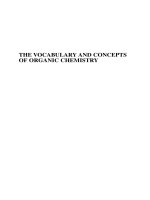
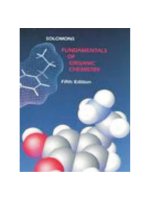
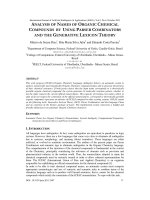
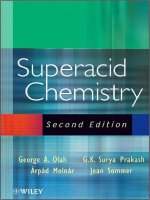

![dyker - handbook of c-h transformations [organic chemistry] (wiley, 2005)](https://media.store123doc.com/images/document/14/ri/ah/medium_eZ1VrCiIJB.jpg)


